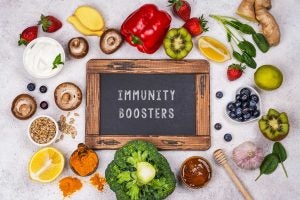Last month I wrote about 5 deceptive food-marketing buzzwords that have been around for a while. With our unique situation this year due to COVID-19, the supplement, food, and beverage industries have been capitalizing off of some newer marketing trends and buzzwords that will likely continue to gain popularity in 2021, but will they help you to fight off the virus? Let’s take a look at a few of these growing trends.

Immunity Boosting
According to The Business Research Company’s Immunity Boosting Food Products Market Global Report 2020-30: Covid 19 Implications And Growth, the global immunity boosting food products market is expected to grow from $16.31 billion in 2019 to $22.76 billion in 2020. The growing demand for immunity-boosting foods and beverages during the COVID-19 pandemic is driving the immunity-boosting food products market size. The market is then expected to reach $24.02 billion in 2023.
Just as quickly as we all became concerned with the ability of our immune system to fight off COVID-19, the market became ready and willing to prey upon those fears. Regardless of how little evidence there is for “immune boosting” food and beverage products to aid the immune system in fighting off the virus, there is no shortage of claims and implications that these products are going to do just that.
Of course, an overall balanced diet can help to support your immune system, but to claim that a specific food or beverage can “boost” the immune system is not only not evidence based, but wouldn’t actually be beneficial. After all, a “boosted” immune system is what happens with autoimmune conditions where the body essentially attacks itself. “Immune support” is another way it can be worded, but that means about as much as “superfood,” which essentially means nothing except that you’ll be shelling out more money for the same product with the addition of a trendy marketing label.

Functional Ingredients
Again, due to the pandemic, consumers are increasingly preferring foods rich in Vitamin C, Vitamin D, and zinc. While vitamin and mineral deficiencies can lead to a weakened immune system, the mere addition of specific vitamins and minerals to a food or beverage does not mean that it will help to strengthen the immune system. As Whole Foods states in its annual Top 10 Food Trend list, “The lines are blurring between the supplement and grocery aisles, and that trend will accelerate in 2021. That means superfoods, probiotics, broths and sauerkrauts.”
Adaptogens are another “functional ingredient” to look out for. While the claims are vast for these magical mushroom powders, the evidence is lacking. Perhaps the claim that they can help to “restore balance” is especially appealing right now with so much uncertainty and lack of balance in our lives during this time, but the claims are severely overreaching. Even if there is some evidence for a specific adaptogen at a specific dose, chances are that it’s not going to be added to a food or beverage product in any significant amount. Foods and beverages typically only contain small amounts of these expensive ingredients in order to be able to state “adaptogens” on the front, but the consumer would have no idea how much is actually even in the product, and it’s likely not that much.

Gut Health
The global digestive health products market is expected to grow from $31.2 billion in 2017 to $59.3 billion by 2025. The link between gut health and the immune system has made consumers more aware of it, again largely due to the emphasis on a healthy immune system this year. Although this is an exciting area of research, much like adaptogen and immunity boosting claims, gut health and microbiome claims are largely overstated.
There has been a lot of hype around the health benefits of prebiotics and probiotics in recent years, but several reviews suggest there needs to be further research on which strains and dosages are effective. The growing popularity of untested and unregulated therapies based in microbiome research, such as prebiotics, probiotics and DIY fecal transplants, could pose health threats to the public. One example of an unsubstantiated marketing claim regarding gut health is from back in 2010 with the Activia commercials starring Jamie Lee Curtis, where she talked about how Activia yogurt kept her “regular.” The Federal Trade Commission launched an investigation, and Dannon paid $21 million in a settlement for false statements. It turns out that studies of Activia generally show that it does absolutely nothing to help your digestive system. The issue is that it can take years from false claims like this being made until something is done about it. By then, a lot of the damage has already been done.
The issue isn’t necessarily that these food and beverage products are unsafe, but if a consumer is purchasing something based off of specific health claims that actually aren’t backed by evidence, they could be forgoing effective diet changes or treatments.
So, as we move into the new year and as the uptick of wellness trends and post-holiday marketing campaigns seek to take advantage of well meaning consumers, just be aware of these new marketing trends. There is no miracle product, and no amount of kombucha can replace an overall balanced diet and COVID-19 precautionary measures such as wearing a mask, social distancing, staying home, washing your hands, and getting the vaccine once it’s available. Here’s to hoping for a 2021 with less COVID-19 and more science literacy.
Food Science Babe is the pseudonym of an agvocate and writer who focuses specifically on the science behind our food. She has a degree in chemical engineering and has worked in the food industry for more than decade, both in the conventional and in the natural/organic sectors.



